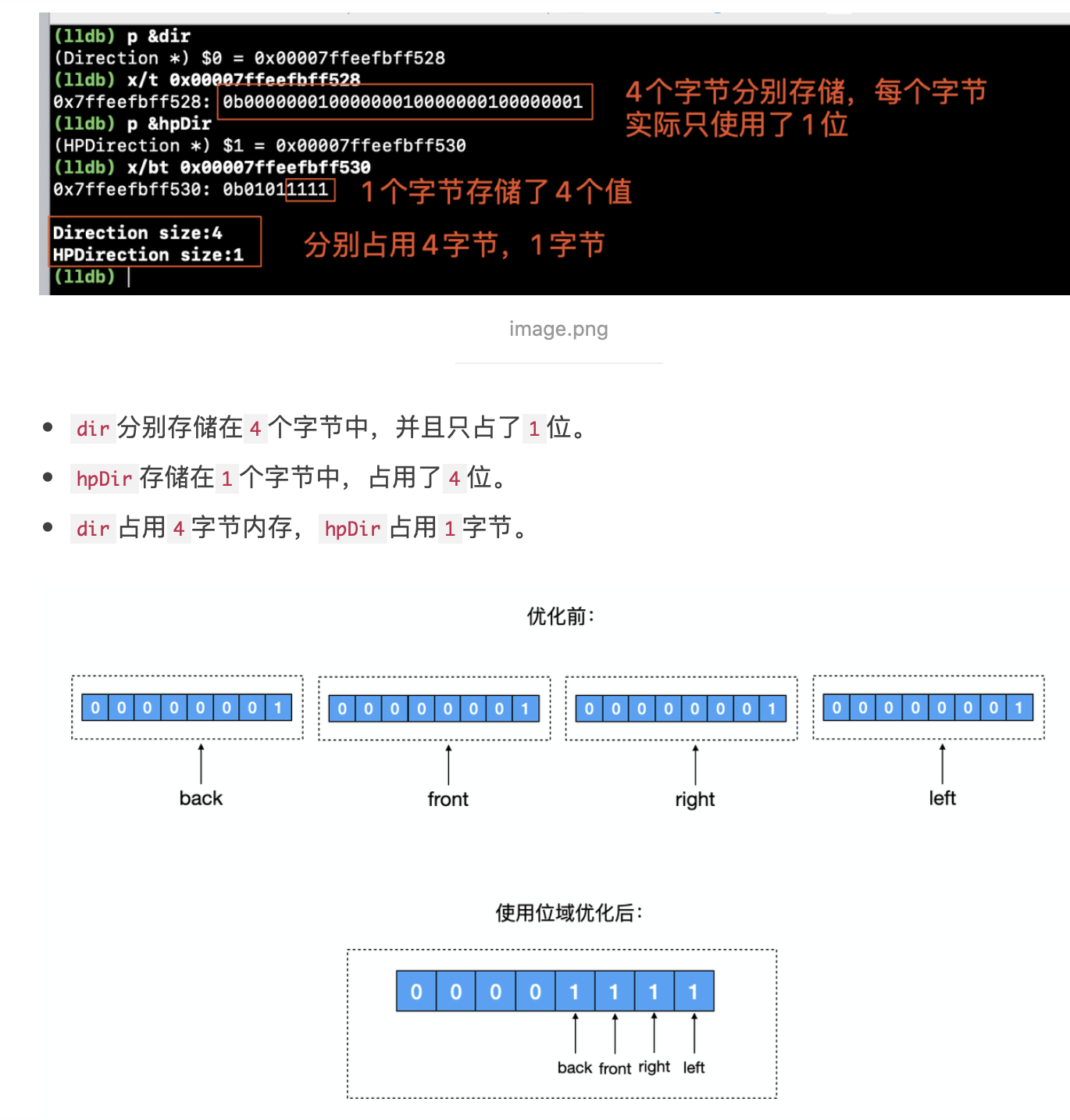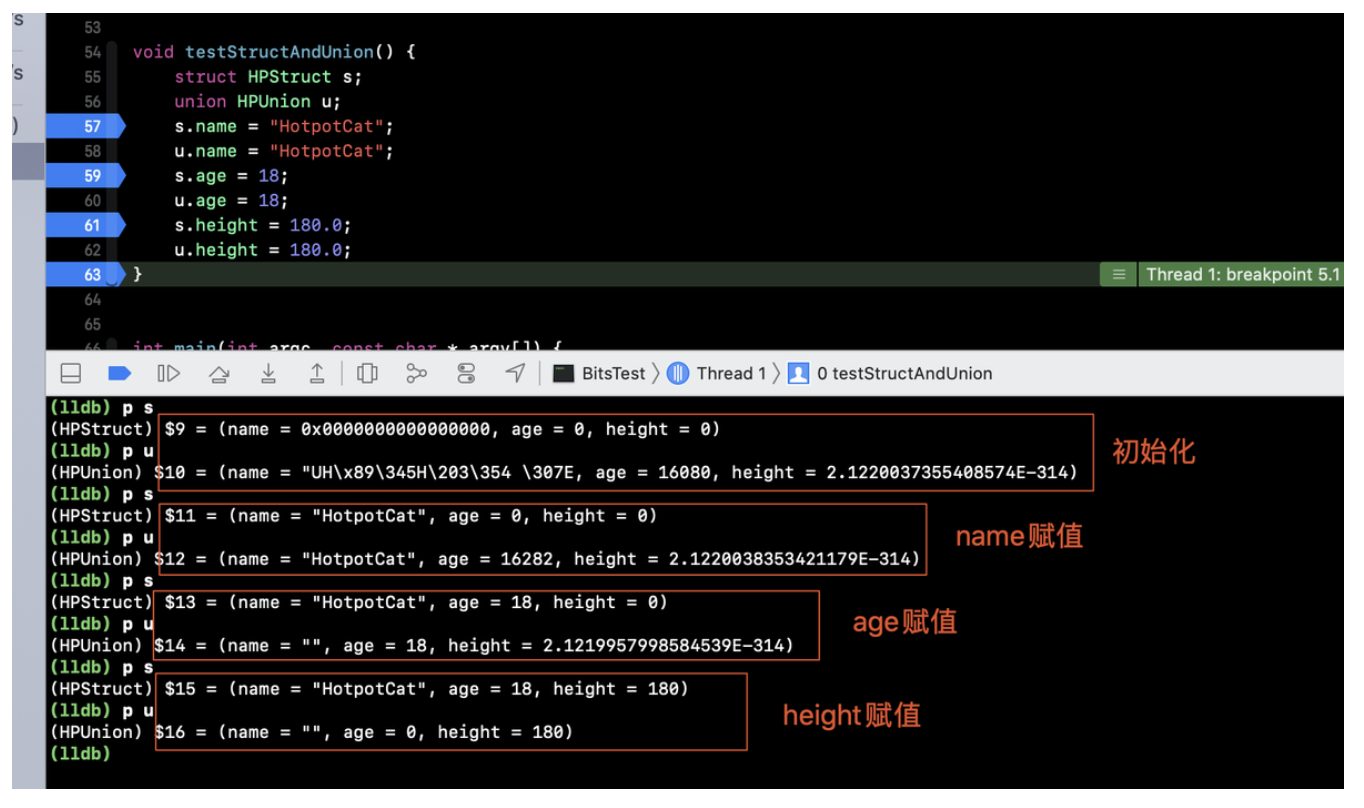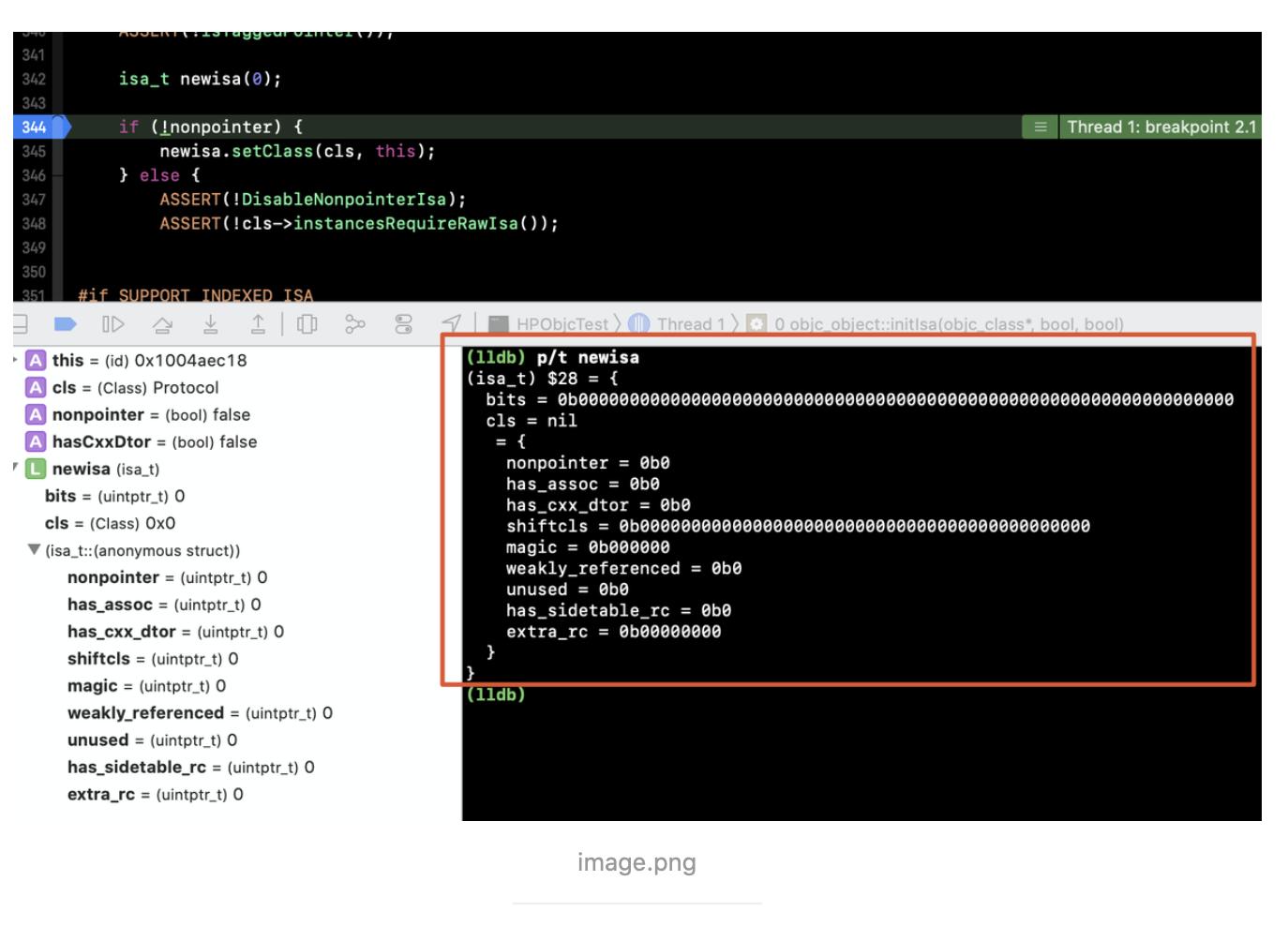OC 对象、位域、isa
一、对象的本质
1.1 clang
1.1.1clang 概述
Clang是一个C语言、C++、Objective-C语言的轻量级编译器。源代码发布于BSD协议下。 Clang将支持其普通lambda表达式、返回类型的简化处理以及更好的处理constexpr关键字。
Clang是一个由Apple主导编写,基于LLVM的C/C++/Objective-C编译器。
它与GNU C语言规范几乎完全兼容(当然,也有部分不兼容的内容, 包括编译命令选项也会有点差异),并在此基础上增加了额外的语法特性,比如C函数重载 (通过__attribute__((overloadable))来修饰函数),其目标(之一)就是超越GCC。
1.1.2 clang与xcrun命令
1.1.2.1 clang
把目标文件编译成c++文件,最简单的方式:
clang -rewrite-objc main.m -o main.cpp如果包含其它SDK,比如UIKit则需要指定isysroot:
clang -rewrite-objc -fobjc-arc -fobjc-runtime=ios-14.0.0 -isysroot /Applications/Xcode.app/Contents/Developer/Platforms/iPhoneSimulator.platform/Developer/SDKs/iPhoneSimulator.sdk main.m -o main.cpp
- 如果找不到
Foundation则需要排查clang版本设置是否正确。使用which clang可以直接查看路径。有些公司会使用clang-format来进行代码格式化,需要排查环境变量中是否导出了相关路径(如果导出先屏蔽掉)。正常路径为/usr/bin/clang。isysroot也可以导出环境变量进行配置方便使用。
1.1.2.2 xcrun(推荐)
xcode安装的时候顺带安装了xcrun命令,xcrun命令在clang的基础上进行了 一些封装,比clang更好用。
模拟器命令:
xcrun -sdk iphonesimulator clang -arch arm64 -rewrite-objc main.m -o main-arm64simulator.cpp真机命令:
xcrun -sdk iphoneos clang -arch arm64 -rewrite-objc main.m -o main-arm64.cpp
1.2 对象c++代码分析
main.m文件如下,直接生成对应的.cpp文件对HotpotCat进行分析。
#import <Foundation/Foundation.h>
@interface HotpotCat : NSObject
@end
@implementation HotpotCat
@end
int main(int argc, const char * argv[]) {
@autoreleasepool {
}
return 0;
}1.2.1 对象在底层是结构体
直接搜索HotpotCat
可以看到生成了HotpotCat_IMPL是一个结构体,那么HotpotCat_IMPL就是HotpotCat的底层实现么?对HotpotCat增加属性hp_name:
@property(nonatomic, copy) NSString *hp_name;重新生成.cpp文件:
这也就验证了HotpotCat_IMPL就是HotpotCat的底层实现,那么说明: 对象在底层的本质就是结构体。
在HotpotCat_IMPL结构体中又嵌套了NSObject_IMPL结构体,这可以理解为继承。NSObject_IMPL定义如下:
struct NSObject_IMPL {
Class isa;
};所以NSObject_IVARS就是成员变量isa。
1.2.2 objc_object & objc_class
在HotpotCat_IMPL上面有如下代码:
typedef struct objc_object HotpotCat;为什么HotpotCat是objc_object类型?这是因为NSObject的底层实现就是objc_object。
同样的Class定义如下:
typedef struct objc_class *Class;
是objc_class类型的结构体指针。
同样可以看到id为objc_object结构体类型指针。
typedef struct objc_object *id;
这也就是id声明的时候不需要*的原因。
1.2.3 setter & getter
在.cpp文件中有以下代码:
// @property(nonatomic, copy) NSString *hp_name;
/* @end */
// @implementation HotpotCat
//这里是setter和getter 参数self _cmd 隐藏参数
static NSString * _I_HotpotCat_hp_name(HotpotCat * self, SEL _cmd) {
//return self + 成员变量偏移
return (*(NSString **)((char *)self + OBJC_IVAR_$_HotpotCat$_hp_name));
}
extern "C" __declspec(dllimport) void objc_setProperty (id, SEL, long, id, bool, bool);
static void _I_HotpotCat_setHp_name_(HotpotCat * self, SEL _cmd, NSString *hp_name) {
objc_setProperty (self, _cmd, __OFFSETOFIVAR__(struct HotpotCat, _hp_name), (id)hp_name, 0, 1);
}
// @end- 根据系统默认注释和函数名称确认这里是
hp_name的setter和getter方法。 getter方法返回hp_name是通过self + 成员变量偏移获取的。getter同理。
二、位域
struct Direction {
BOOL left;
BOOL right;
BOOL front;
BOOL back;
};上面是一个记录方向的结构体。这个结构体占用4字节32位:00000000 00000000 00000000 00000000。但是对于BOOL值只有两种情况YES/NO。那么如果能用4位0000来代替前后左右,就只需要0.5个字节就能表示这个数据结构了(虽然只需要0.5字节,但是数据单元最小为1字节)。那么Direction的实现显然浪费了3倍的空间。有什么优化方式呢?位域
2.1 结构体位域
修改Direction为HPDirection:
struct HPDirection {
BOOL left : 1;
BOOL right : 1;
BOOL front : 1;
BOOL back : 1;
};格式为:数据类型 位域名称:位域长度。
验证:
struct Direction dir;
dir.left = YES;
dir.right = YES;
dir.front = YES;
dir.back = YES;
struct HPDirection hpDir;
hpDir.left = YES;
hpDir.right = YES;
hpDir.front = YES;
hpDir.back = YES;
printf("\nDirection size:%zu\nHPDirection size:%zu\n",sizeof(dir),sizeof(hpDir));
2.2 联合体
2.2.1结构体&联合体对比
//结构体联合体对比
//共存
struct HPStruct {
char *name;
int age;
double height;
};
//互斥
union HPUnion {
char *name;
int age;
double height;
};
void testStructAndUnion() {
struct HPStruct s;
union HPUnion u;
s.name = "HotpotCat";
u.name = "HotpotCat";
s.age = 18;
u.age = 18;
s.height = 180.0;
u.height = 180.0;
}HPStruct结构体和HPUnion共用体,在整个赋值过程中变化如下:
总结:
- 结构体(
struct)中所有变量是“共存”的。
优点:“有容乃大”, 全面;
缺点:struct内存空间的分配是粗放的,不管用不用全分配。 - 联合体/共用体(
union)中是各变量是“互斥”的。
缺点:不够“包容”;
优点:内存使用更为精细灵活,节省了内存空间。 - 联合体在未进行赋值前数据成员会存在脏数据。
2.2.2 联合体位域
HPDirectionItem.h:
@interface HPDirectionItem : NSObject
@property (nonatomic, assign) BOOL left;
@property (nonatomic, assign) BOOL right;
@property (nonatomic, assign) BOOL front;
@property (nonatomic, assign) BOOL back;
@endHPDirectionItem.m:#define HPDirectionLeftMask (1 << 0)
#define HPDirectionRightMask (1 << 1)
#define HPDirectionFrontMask (1 << 2)
#define HPDirectionBackMask (1 << 3)
#import "HPDirectionItem.h"
@interface HPDirectionItem () {
//这里bits和struct用任一一个就可以,结构体相当于是对bits的解释。因为是共用体用同一块内存。
union {
char bits;
//位域,这里是匿名结构体(anonymous struct)
struct {
char left : 1;
char right : 1;
char front : 1;
char back : 1;
};
}_direction;
}
@end
@implementation HPDirectionItem
- (instancetype)init {
self = [super init];
if (self) {
_direction.bits = 0b00000000;
}
return self;
}
- (void)setLeft:(BOOL)left {
if (left) {
_direction.bits |= HPDirectionLeftMask;
} else {
_direction.bits &= ~HPDirectionLeftMask;
}
}
- (BOOL)left {
return _direction.bits & HPDirectionLeftMask;
}
//……
//其它方向设置同理
//……
@endHPDirectionItem是一个方向类,类中有一个_direction的共用体。_direction中有bits和anonymous struct,这里anonymous struct相当于是对bits的一个解释(因为是共用体,同一个字节内存。下面的调试截图很好的证明力这一点)。- 通过对
bits位移操作来进行数据的存储,其实就相当于对结构体位域的操作。连这个可以互相操作。
所以可以将setter和getter通过结构体去操作,效果和操作bits相同:
- (void)setLeft:(BOOL)left {
_direction.left = left;
}
- (BOOL)left {
return _direction.left;
}
当然也可以两者混用:
- (void)setLeft:(BOOL)left {
_direction.left = left;
}
- (BOOL)left {
return _direction.bits & HPDirectionLeftMask;
}
根本上还是对同一块内存空间进行操作。
调用:
void testUnionBits() {
HPDirectionItem *item = [HPDirectionItem alloc];
item.left = 1;
item.right = 1;
item.front = 1;
item.back = 1;
item.right = 0;
item.back = 0;
NSLog(@"testUnionBits");
}
这样整个赋值流程就符合预期满足需求了。
- 联合体位域作用:优化内存空间和访问速度。
三、 isa
在alloc分析的文章中已经了解到执行完initIsa后将alloc开辟的内存与类进行了关联。在initIsa中首先创建了isa_t也就是isa,去掉方法后它的主要结构如下:
union isa_t {
//……
uintptr_t bits;
private:
Class cls;
public:
#if defined(ISA_BITFIELD)
struct {
ISA_BITFIELD; // defined in isa.h
};
//……
#endif
//……
};
它是一个union,包含了bits、cls(私有)和一个匿名结构体,所以这3个其实是一个内容,不同表现形式罢了。这个结构似曾相识,与2.2.2中联合体位域一样。不同的是isa_t占用8字节64位。
没有关联类时isa分布(默认都是0,没有指向):

bits和cls分析起来比较困难,既然三者一样,那么isa_t的核心就是ISA_BITFIELD。
作者:HotPotCat
链接:https://www.jianshu.com/p/84749f140139
